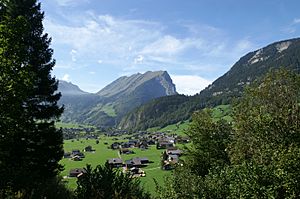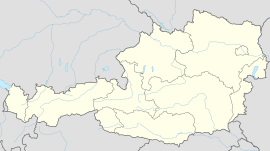Au, Vorarlberg facts for kids
Quick facts for kids
Au
|
||
|---|---|---|
 |
||
|
||

Location in the district
|
||
| Country | Austria | |
| State | Vorarlberg | |
| District | Bregenz | |
| Area | ||
| • Total | 44.91 km2 (17.34 sq mi) | |
| Elevation | 800 m (2,600 ft) | |
| Time zone | UTC+1 (CET) | |
| • Summer (DST) | UTC+2 (CEST) | |
| Postal code |
6883
|
|
| Area code | 05515 | |
| Vehicle registration | B | |
| Website | www.au-schoppernau.at | |
Au (pronounced "Ow") is a charming town located in the beautiful Bregenz Forest region of Vorarlberg, Austria. It's known for its unique scattered layout and rich history.
Contents
Geography
Au is nestled in the Bregenz Forest, a lovely area in Vorarlberg. It's part of the Bregenz region and sits in the Upper Bregenz Forest.
About 40% of Au's 45 square kilometers is covered by forests. Another 34.4% is used for Almwirtschaft, which means alpine pasture farming. This is a special way of farming where animals graze in mountain meadows during summer.
A Scattered Village
Unlike many towns with a clear center, Au is a "scattered village" (in German, Streudorf). This means it's made up of several smaller areas instead of one main hub. These areas include Am Stein, Argenau, Argenstein, Argenzipfel, Jaghausen, Kreuzgasse, Lebernau, Lugen, Lisse, Rehmen, Schrecken, and Wieden.
The town hall is in Argenau, but the main church is in Jaghausen. The area of Rehmen also has its own church.
The Bregenzer Ach river, the biggest river in the region, flows right through Au. It divides the town into two parts:
- The Schattseite (meaning "shady side") includes areas like Argenau, Argenzipfel, and Wieden.
- The Sonnseite (meaning "sunny side") mainly includes Rehmen and Schrecken.
The L200 road runs alongside the river. This road is the main route for getting around the Bregenz Forest.
History of Au
The name "Au" probably comes from an old German word, ouwa. This word means "river meadow" or "floodplain," which makes sense because the area is close to rivers and streams.
The first people known to live in the Au region were the Alemanni. They came mostly from the nearby Vorarlberg Rhine Valley or the Bregenz area. People likely started settling here permanently between 1200 and 1300. A small church was built in Jaghausen in 1372.
The land where Au is today was first owned by King Rudolf of Habsburg. He later gave it to the Counts of Bregenz-Montfort. The Counts of Feldkirch-Montfort then took over the area and used it mainly for hunting. This is how the name ‘Jaghausen in den Owen’ came about, because the counts built a hunting lodge there. In 1375, Count Hugo von Montfort sold the area to Further Austria.
Au became very important for the Au guild. This was a group of skilled builders and artists who helped create the amazing Baroque architecture you can see in southern Germany, Switzerland, and Alsace. Families like the Thumb and Beer, who were master builders from Au, developed a special Baroque style in the 1600s.
From 1805 to 1814, Au was part of the Kingdom of Bavaria. After that, it returned to the Austrian Empire. Since 1861, Au has been part of the Vorarlberg province. After World War II, Au was in the French-controlled part of Austria until 1955.
Population
| Historical population | ||
|---|---|---|
| Year | Pop. | ±% |
| 1869 | 1,039 | — |
| 1880 | 1,060 | +2.0% |
| 1890 | 1,067 | +0.7% |
| 1900 | 1,116 | +4.6% |
| 1910 | 1,210 | +8.4% |
| 1923 | 1,080 | −10.7% |
| 1934 | 1,269 | +17.5% |
| 1939 | 1,263 | −0.5% |
| 1951 | 1,414 | +12.0% |
| 1961 | 1,440 | +1.8% |
| 1971 | 1,476 | +2.5% |
| 1981 | 1,466 | −0.7% |
| 1991 | 1,572 | +7.2% |
| 2001 | 1,643 | +4.5% |
| 2011 | 1,692 | +3.0% |
| 2017 | 1,728 | +2.1% |
Culture
The Au Guild
In 1651, the Auer Zunft (Guild of Au) was started in Au by Michael Beer. This was a special group of builders, sculptors, and carpenters. Between 1670 and 1700, more than 90% of all male workers in Au-Schoppernau were builders!
Master builders and craftspeople from the Bregenz Forest were very important. They played a big part in building about 600 churches and monasteries in the Baroque style during the 17th and 18th centuries. Members of the Guild of Au received 60% of the more than 700 big building jobs given to people from Vorarlberg.
Many important members of the Au Guild came from famous architect families like Beer, Moosbrugger, and Thumb.
In 2021, the Museum of Baroque Master Builders opened in Au. It shows off the amazing work done by the Guild of Au.
Economy and Infrastructure
Tourism
A major part of Au's economy is tourism. Many local families rent out rooms or apartments to visitors. There are also several hotels, some offering special activities like wellness, sports, or motorbiking tours. In the past, farming was the main way people made a living, but now tourism is very important.
Transportation
Au is located on the L200, which is called the Bregenzerwald Bundesstraße. This road connects to the L193, the Faschina Bundesstraße. The L193 is the main road to the skiing resort of Damüls.
For public transport, there is the Postbus Line 40. It runs from Dornbirn to Schoppernau. In winter, there's also a free bus service that runs through the town for skiers and local people.
Education
Au has a kindergarten (for young children), a Volksschule (primary school), and a Hauptschule (lower secondary school). All these schools are in one building in the Schrecken area. The secondary school also serves students from nearby towns like Schnepfau, Schoppernau, Damüls, and Schröcken.
Personalities
- Kaspar Moosbrugger (a famous builder from the Vorarlberg School; born May 16, 1656, in Au; died August 26, 1723, in Einsiedeln)
- Franz Beer (a master builder and one of the founders of the Vorarlberg School; born April 1, 1660, in Au; died January 21, 1726, in Bezau)
- Jan Zwischenbrugger (a professional footballer; born June 16, 1990, in Au. He has played over 200 league games for Rheindorf Altach.)
See also
 In Spanish: Au (Austria) para niños
In Spanish: Au (Austria) para niños



